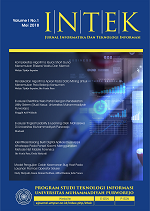Pembaharuan Data Kependudukan Permanen dan Non-Permanen di Kabupaten Purworejo dengan Metode Crowdsourcing
Abstract
The primary issue in updating population data in Purworejo Regency lies in the lack of inter-agency integration, limited community participation, and the absence of a system capable of real-time data updates. To address these challenges, this study aims to develop a participatory and integrated model for updating permanent and non-permanent population data using a crowdsourcing approach. A mixed-method design was employed, combining quantitative surveys of citizens and village officials with qualitative data gathered through in-depth interviews and focus group discussions (FGDs) involving key stakeholders such as the Civil Registry Office (Disdukcapil), Statistics Bureau (BPS), Communication and Informatics Agency, the Education and Health Offices, and local governments. The results indicate that the proposed model—based on a middleware system and digital portal—facilitates automated data exchange via APIs, enables citizen-led reporting, and ensures data security and validation through centralized verification. The model was deemed feasible and applicable based on stakeholder validation and is expected to enhance the accuracy, efficiency, and inclusiveness of population data management, supporting the development of a Smart Society in Purworejo Regency.
References
[2] A. E. Kim, A. J. Lieberman, and D. Dench, “Crowdsourcing data collection of the retail tobacco environment: case study comparing data from crowdsourced workers to trained data collectors,” Tob Control, vol. 24, no. e1, pp. e6–e9, Mar. 2015, doi: 10.1136/tobaccocontrol-2013-051298.
[3] A. Comber, P. Mooney, R. S. Purves, D. Rocchini, and A. Walz, “Crowdsourcing: It Matters Who the Crowd Are. The Impacts of between Group Variations in Recording Land Cover,” PLoS One, vol. 11, no. 7, p. e0158329, Jul. 2016, doi: 10.1371/journal.pone.0158329.
[4] J. D. Kraemer, A. A. Strasser, E. N. Lindblom, R. S. Niaura, and D. Mays, “Crowdsourced data collection for public health: A comparison with nationally representative, population tobacco use data,” Prev Med (Baltim), vol. 102, pp. 93–99, Sep. 2017, doi: 10.1016/j.ypmed.2017.07.006.
[5] G. Sierpiński, A. Pijoan, K. Turoń, and M. Staniek, “Challenges Related to the Implementation and Development of Electromobility in Cities,” 2021, pp. 203–213. doi: 10.1007/978-3-030-50010-8_18.
[6] Y. Jiang, B. Guo, X. Zhang, H. Tian, Y. Wang, and M. Cheng, “A bibliometric and scientometric review of research on crowdsourcing in smart cities,” IET Smart Cities, vol. 5, no. 1, pp. 1–18, Mar. 2023, doi: 10.1049/smc2.12048.
[7] U. Ependi, A. F. Rochim, and A. Wibowo, “An Assessment Model for Sustainability City Using Crowdsourced Data Based on General System Theory: A Design Science Methodology Approach,” Sep. 06, 2023. doi: 10.20944/preprints202309.0349.v1.
[8] M. Aldabbas, S. Teufel, B. Teufel, and V. Pasquier, “Smart Sovereignty: The Security Shield for Smart Society 5.0,” International Journal for Digital Society, vol. 11, no. 2, pp. 1619–1626, Dec. 2020, doi: 10.20533/ijds.2040.2570.2020.0202.
[9] J. Monaghan et al., “Citizen science approaches to crowdsourcing food environment data: A scoping review of the literature,” Obesity Reviews, vol. 24, no. 11, Nov. 2023, doi: 10.1111/obr.13618.
[10] E. L. Uhlmann et al., “Scientific Utopia III: Crowdsourcing Science,” Perspectives on Psychological Science, vol. 14, no. 5, pp. 711–733, Sep. 2019, doi: 10.1177/1745691619850561.
[11] O. Korovina, M. Baez, and F. Casati, “Reliability of crowdsourcing as a method for collecting emotions labels on pictures,” BMC Res Notes, vol. 12, no. 1, p. 715, Dec. 2019, doi: 10.1186/s13104-019-4764-4.
[12] D. Leibovici et al., “Earth Observation for Citizen Science Validation, or Citizen Science for Earth Observation Validation? The Role of Quality Assurance of Volunteered Observations,” Data (Basel), vol. 2, no. 4, p. 35, Oct. 2017, doi: 10.3390/data2040035.
[13] S. Gisdakis, T. Giannetsos, and P. Papadimitratos, “Security, Privacy, and Incentive Provision for Mobile Crowd Sensing Systems,” IEEE Internet Things J, vol. 3, no. 5, pp. 839–853, Oct. 2016, doi: 10.1109/JIOT.2016.2560768.
[14] “A Lightweight and Privacy-Preserving Answer Collection Scheme for Mobile Crowdsourcing,” KSII Transactions on Internet and Information Systems, vol. 15, no. 8, Aug. 2021, doi: 10.3837/tiis.2021.08.007.
[15] N. Iskender and T. Polzehl, “An Empirical Analysis of an Internal Crowdsourcing Platform: IT Implications for Improving Employee Participation,” 2021, pp. 103–134. doi: 10.1007/978-3-030-52881-2_6.
[16] G. Chatzimilioudis, A. Konstantinidis, C. Laoudias, and D. Zeinalipour-Yazti, “Crowdsourcing with Smartphones,” IEEE Internet Comput, vol. 16, no. 5, pp. 36–44, Sep. 2012, doi: 10.1109/MIC.2012.70.
[17] C. S. Lee, D. H. Goh, H. Osop, S. J. Sin, and Y. L. Theng, “Public services or private gains: Motives behind participation on a mobile crowdsourcing application in a smart city,” Proceedings of the Association for Information Science and Technology, vol. 54, no. 1, pp. 495–498, Jan. 2017, doi: 10.1002/pra2.2017.14505401055.
[18] N. Evita and A. A. Mukhaer, “Evaluasi Komunikasi dan Literasi Digital Warga Jakarta dalam Implementasi Society 5.0,” Jurnal Riset Komunikasi, vol. 5, no. 2, pp. 172–186, Aug. 2022, doi: 10.38194/jurkom.v5i2.541.
[19] U.- Wahid and N. Amalia, “Tantangan Humas Pemerintah Daerah dalam Upaya Publikasi Inovasi Program Smart City,” Nyimak: Journal of Communication, vol. 4, no. 1, p. 35, Mar. 2020, doi: 10.31000/nyimak.v4i1.2300.
Copyright (c) 2025 Murhadi, Murry Harmawan Saputra, Intan Puspita Sari, Suyitno, Jeki Mediantari Wahyu Wibawanti

This work is licensed under a Creative Commons Attribution-NonCommercial 4.0 International License.



